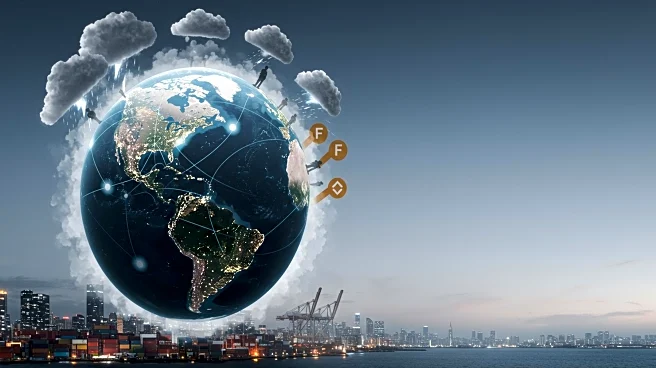What's Happening?
The global economic growth rate is projected to decline from 3.1% in 2024 to 2.9% in 2025, primarily due to US tariffs, ongoing conflicts, and unforeseen climate events. According to Euromonitor International, the US real GDP growth is expected to slow to 1.6%, with inflation rising to 3%. The risk of a global trade war remains a significant concern, as US tariffs could potentially cost companies up to USD 1.2 trillion in a pessimistic scenario. The report highlights that extreme weather events and geopolitical tensions are disrupting global supply chains, prompting manufacturers to focus on resilience by near-shoring production and developing future-proof products. A surge in commodity prices could further exacerbate global inflation, adding pressure on businesses.
Why It's Important?
The potential slowdown in global economic growth and the risk of a trade war could have significant implications for US industries and the broader economy. Increased tariffs and supply chain disruptions may lead to higher costs for manufacturers and importers, affecting profitability and competitiveness. The anticipated rise in inflation could impact consumer purchasing power and economic stability. Businesses may need to adapt by diversifying supply chains and implementing agile strategies to navigate the uncertain landscape. The situation underscores the importance of strategic planning and innovation to maintain growth and resilience in the face of global challenges.
What's Next?
As the US faces a growing risk of a policy-induced recession by 2026, businesses and policymakers may need to consider measures to mitigate the impact of tariffs and climate events. Companies might focus on diversifying supply chains and investing in resilient infrastructure to withstand disruptions. Policymakers could explore trade agreements and climate policies to stabilize the economic outlook. The evolving geopolitical landscape may require ongoing assessment and adaptation to ensure economic resilience and growth.
Beyond the Headlines
The broader implications of these developments include potential shifts in global trade dynamics and economic power. As Southeast Asian countries and India continue to offer growth opportunities, businesses may increasingly look to these regions for expansion. The focus on resilience and innovation could drive long-term changes in manufacturing and supply chain strategies, emphasizing sustainability and adaptability. The situation highlights the interconnectedness of global economies and the need for collaborative approaches to address shared challenges.













